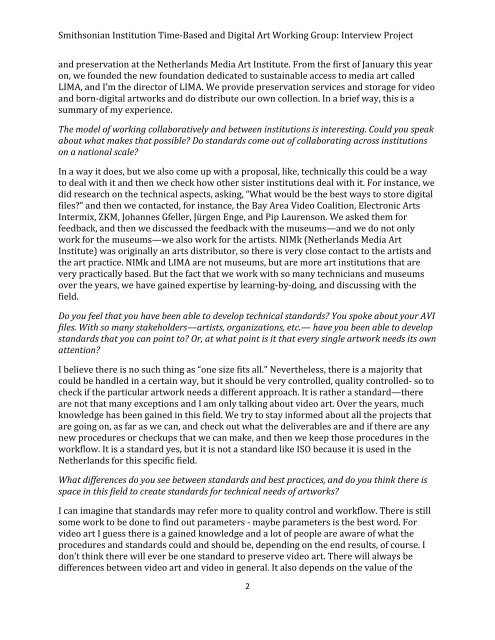Gaby Wijers - Smithsonian Institution
Gaby Wijers - Smithsonian Institution
Gaby Wijers - Smithsonian Institution
Create successful ePaper yourself
Turn your PDF publications into a flip-book with our unique Google optimized e-Paper software.
<strong>Smithsonian</strong> <strong>Institution</strong> Time-Based and Digital Art Working Group: Interview Project<br />
and preservation at the Netherlands Media Art Institute. From the first of January this year<br />
on, we founded the new foundation dedicated to sustainable access to media art called<br />
LIMA, and I’m the director of LIMA. We provide preservation services and storage for video<br />
and born-digital artworks and do distribute our own collection. In a brief way, this is a<br />
summary of my experience.<br />
The model of working collaboratively and between institutions is interesting. Could you speak<br />
about what makes that possible? Do standards come out of collaborating across institutions<br />
on a national scale?<br />
In a way it does, but we also come up with a proposal, like, technically this could be a way<br />
to deal with it and then we check how other sister institutions deal with it. For instance, we<br />
did research on the technical aspects, asking, “What would be the best ways to store digital<br />
files?” and then we contacted, for instance, the Bay Area Video Coalition, Electronic Arts<br />
Intermix, ZKM, Johannes Gfeller, Jürgen Enge, and Pip Laurenson. We asked them for<br />
feedback, and then we discussed the feedback with the museums—and we do not only<br />
work for the museums—we also work for the artists. NIMk (Netherlands Media Art<br />
Institute) was originally an arts distributor, so there is very close contact to the artists and<br />
the art practice. NIMk and LIMA are not museums, but are more art institutions that are<br />
very practically based. But the fact that we work with so many technicians and museums<br />
over the years, we have gained expertise by learning-by-doing, and discussing with the<br />
field.<br />
Do you feel that you have been able to develop technical standards? You spoke about your AVI<br />
files. With so many stakeholders—artists, organizations, etc.— have you been able to develop<br />
standards that you can point to? Or, at what point is it that every single artwork needs its own<br />
attention?<br />
I believe there is no such thing as “one size fits all.” Nevertheless, there is a majority that<br />
could be handled in a certain way, but it should be very controlled, quality controlled- so to<br />
check if the particular artwork needs a different approach. It is rather a standard—there<br />
are not that many exceptions and I am only talking about video art. Over the years, much<br />
knowledge has been gained in this field. We try to stay informed about all the projects that<br />
are going on, as far as we can, and check out what the deliverables are and if there are any<br />
new procedures or checkups that we can make, and then we keep those procedures in the<br />
workflow. It is a standard yes, but it is not a standard like ISO because it is used in the<br />
Netherlands for this specific field.<br />
What differences do you see between standards and best practices, and do you think there is<br />
space in this field to create standards for technical needs of artworks?<br />
I can imagine that standards may refer more to quality control and workflow. There is still<br />
some work to be done to find out parameters - maybe parameters is the best word. For<br />
video art I guess there is a gained knowledge and a lot of people are aware of what the<br />
procedures and standards could and should be, depending on the end results, of course. I<br />
don’t think there will ever be one standard to preserve video art. There will always be<br />
differences between video art and video in general. It also depends on the value of the<br />
2
















